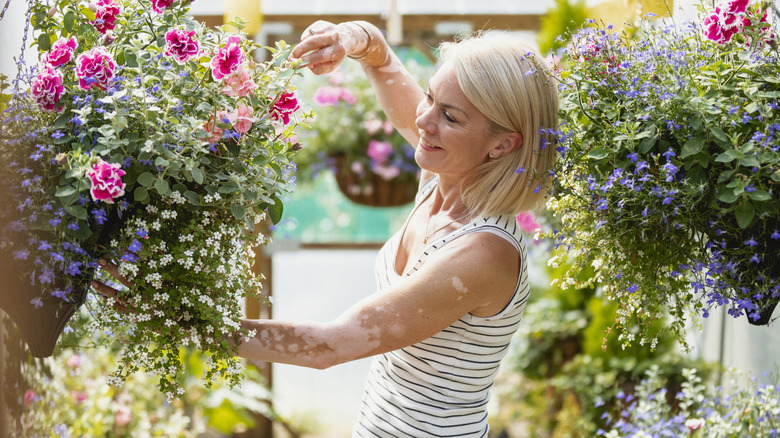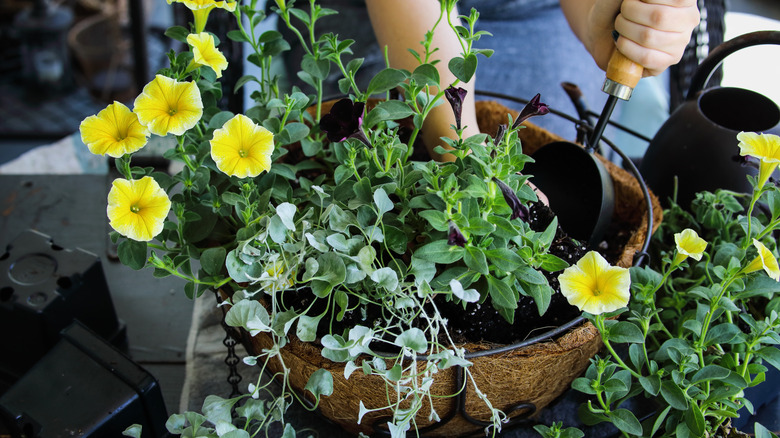The Plastic Nursery Pot Hack That'll Double The Beauty Of Your Hanging Planter Baskets
We may receive a commission on purchases made from links.
You've probably heard of the concept of bottomless planters, where you cut the bottom out of a pot, sit it on the ground or your garden bed, and plant into it. It's often proposed by horticultural experts as an alternative to raised garden beds or a way to increase planting space in a small garden. Well, you can apply the same idea to plastic nursery pots and hanging planter baskets, albeit on a much smaller scale. Cut the bottom from the plastic nursery pot and place it atop the soil in your chosen hanging planter. Fill it with a few of your favorite trailing flowering annuals, the perfect thriller-spiller-thriller combo, or a selection of flavorful herbs that thrive when grown in hanging baskets.
If you don't already have old planters to upcycle, ask family, friends, and neighbors if they have any going spare. Wash them in warm, soapy water and a scrubbing brush then sterilize them with bleach and water at a 9:1 ratio to remove any pests, bacteria and viruses, or other contamination. Alternatively, buy 100 RAOOKIF 5 Inch Plastic Nursery Pots for just under $23. Choose a hanging basket with enough room around the inner pot for your chosen plants. A good guide is at least 6 inches of depth for shallow-rooted plants. You'll also need some container potting mix — two 8-quart bags of Miracle-Gro Moisture Control Potting Mix costs about $14 — and a cutting implement: an old pair of pruning shears, sharp scissors, aviation snips/mini aviation snips, or a heavy-duty box cutter are all good options.
Cut the bottom from the planter to assemble your tiered hanging basket
Ready to attempt this creative way to reuse plastic nursery pots in your garden? You need to get that bottom off the planter. Don a pair of thick gloves for safety, particularly if you're using a box cutter. Hold the pot firmly in one hand and insert the blade into the plastic right where the wall meets the base. You can also start cutting outward from one of the drainage holes, then maneuver the blade around the base when you hit the wall. Experiment with each method to see which you find easier. Discard the plastic base.
Fill your hanging planter basket with potting mix just as you would normally, leaving about half to 1 inch of space between the rim of the basket and surface of the mix. Add slow-release fertilizer (if it's not already included in the mix) and, optionally, Pleasant Plus Water Storing Crystals — about $16 for a 12-ounce bag — to improve water retention.
Holding your hanging basket steady, press the bottomless plastic nursery pot into roughly the center of the soil. Aim for about 1 or 2 inches down — deep enough that the pot doesn't wobble too much. Fill with the same plastic planter with the same potting mix and additives you used in the hanging basket. Lift the entire arrangement with both pots to test how heavy it is. Depending on how much height and weight you add with the new plastic nursery planter, you may need to swap out the original plastic cords or chains with longer or heavier alternatives.
What to plant in your double-sized hanging basket and alterations
Hanging planters are inherently shallow; the fact that they hang limits their size and depth. Choosing drought-resistant flowers perfect for hanging baskets will ensure you see success — for example, salvia and pelargoniums for sun or alyssum, oxalis, and ferns for shade. Emphasize your thrillers by planting them in the center, and fill the outer ring (outside the plastic nursery planter) with trailing plants. There are benefits outside of improved aesthetics to including the inner plastic nursery pot in your planter. The halo-like inner pot may protect vulnerable young plants from pest and weather damage until they get large enough. It could also help stop popular vigorous hanging planter spreaders like mint, lantanas, or greater periwinkle, from taking over the rest of your planter, especially if you bury that top plastic nursery pot nearly to the base of the basket.
Create tiered hanging planters by pushing the three-pronged plastic hanger or chain through the drainage holes in the basket and hooking the next basket to it. Fill and add the bottomless plastic nursery pots as usual. Or, stack the baseless pot into a hanging planter that's just slightly larger to increase the overall planting depth for deep-rooted plants. Just make sure the resulting planting system isn't too tall or the planter may hang lopsided. You could also replace the plastic nursery pot with something more attractive. Cut the bottom out of a small wicker basket or terracotta pots, though the cutting process is ,more challenging and the pot decidedly heavier, with the latter example.

